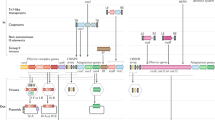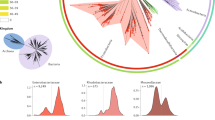Abstract
DNA replication is fundamental to the propagation of cellular life. Remarkably, the bacterial replication machinery is distinct from that used by archaea and eukaryotes. In this article, we discuss the role that lateral gene transfer by extra-chromosomal elements might have had in shaping the replication machinery and even modulating the manner in which host cellular genomes are replicated.
This is a preview of subscription content, access via your institution
Access options
Subscribe to this journal
Receive 12 print issues and online access
$189.00 per year
only $15.75 per issue
Buy this article
- Purchase on Springer Link
- Instant access to full article PDF
Prices may be subject to local taxes which are calculated during checkout



Similar content being viewed by others
References
Woese, C. R. & Fox, G. E. Phylogenetic structure of the prokaryotic domain: the primary kingdoms. Proc. Natl Acad. Sci. USA 74, 5088 (1977).
Leipe, D., Aravind, L. & Koonin, E. Did DNA replication evolve twice independently? Nucleic Acids Res. 27, 3389–3401 (1999).
Edgell, D. & Doolittle, W. Archaea and the origin(s) of DNA replication proteins. Cell 89, 995–998 (1997).
Erzberger, J. P., Pirruccello, M. M. & Berger, J. M. The structure of bacterial DnaA: implications for general mechanisms underlying DNA replication initiation. EMBO J. 21, 4763–4773 (2002).
Liu, J. Y. et al. Structure and function of Cdc6/Cdc18: implications for origin recognition and checkpoint control. Mol. Cell 6, 637–648 (2000).
Iyer, L. M., Leipe, D. D., Koonin, E. V. & Aravind, L. Evolutionary history and higher order classification of AAA plus ATPases. J. Struct. Biol. 146, 11–31 (2004).
Erzberger, J. P. & Berger, J. M. Evolutionary relationships and structural mechanisms of AAA plus proteins. Ann. Rev. Biophys. Biomol. Struct. 35, 93–114 (2006).
Indiani, C. & O'Donnell, M. The replication clamp-loading machine at work in the three domains of life. Nature Rev. Mol. Cell Biol. 7, 751–761 (2006).
Aravind, L., Leipe, D. D. & Koonin, E. V. Toprim — a conserved catalytic domain in type IA and II topoisomerases, DnaG-type primases, OLD family nucleases and RecR proteins. Nucleic Acids Res. 26, 4205–4213 (1998).
Lao-Sirieix, S. H., Pellegrini, L. & Bell, S. D. The promiscuous primase. Trends Genet. 21, 568–572 (2005).
Iyer, L. M., Koonin, E. V., Leipe, D. D. & Aravind, L. Origin and evolution of the archaeo–eukaryotic primase superfamily and related palm-domain proteins: structural insights and new members. Nucleic Acids Res. 33, 3875–3896 (2005).
Braithwaite, D. K. & Ito, J. Compilation, alignment, and phylogenetic-relationships of DNA-polymerases. Nucleic Acids Res. 21, 787–802 (1993).
Bailey, S., Wing, R. A. & Steitz, T. A. The structure of T. aquaticus DNA polymerase III is distinct from eukaryotic replicative DNA polymerases. Cell 126, 893–904 (2006).
Costa, A. & Onesti, S. The MCM complex: (just) a replicative helicase? Biochem. Soc. Trans. 36, 136–140 (2008).
Tanaka, S. et al. CDK-dependent phosphorylation of Sld2 and Sld3 initiates DNA replication in budding yeast. Nature 445, 328–332 (2007).
Zegerman, P. & Diffley, J. F. X. Phosphorylation of Sld2 and Sld3 by cyclin-dependent kinases promotes DNA replication in budding yeast. Nature 445, 281–285 (2007).
Woese, C. R. The universal ancestor. Proc. Natl Acad. Sci. USA 95, 6854–6859 (1998).
Forterre, P. Displacement of cellular proteins by functional analogues from plasmids or viruses could explain puzzling phylogenies of many DNA informational proteins. Mol. Microbiol. 33, 457–465 (1999).
Forterre, P. Three RNA cells for ribosomal lineages and three DNA viruses to replicate their genomes: a hypothesis for the origin of cellular domain. Proc. Natl Acad. Sci. USA 103, 3669–3674 (2006).
Benson, S. D., Bamford, J. K. H., Bamford, D. H. & Burnett, R. M. Viral evolution revealed by bacteriophage PRD1 and human adenovirus coat protein structures. Cell 98, 825–833 (1999).
Abrescia, N. G. A. et al. Insights into assembly from structural analysis of bacteriophage PRD1. Nature 432, 68–74 (2004).
Khayat, R. et al. Structure of an archaeal virus capsid protein reveals a common ancestry to eukaryotic and bacterial viruses. Proc. Natl Acad. Sci. USA 102, 18944–18949 (2005).
Koonin, E. V., Senkevich, T. G. & Dolja, V. V. The ancient Virus World and evolution of cells. Biol. Direct 1, 29 (2006).
Bernander, R., Dasgupta, S. & Nordstrom, K. The Escherichia coli cell cycle and the plasmid R1 replication cycle in the absence of the DnaA protein. Cell 64, 1145–1153 (1991).
Koppes, L. J. H. Nonrandom F-plasmid replication in Escherichia coli K-12. J. Bacteriol. 174, 2121–2123 (1992).
Filee, J., Forterre, P. & Laurent, J. The role played by viruses in the evolution of their hosts: a view based on informational protein phylogenies. Res. Microbiol. 154, 237–243 (2003).
Filee, J., Forterre, P., Sen-Lin, T. & Laurent, J. Evolution of DNA polymerase families: evidences for multiple gene exchange between cellular and viral proteins. J. Mol. Evol. 54, 763–773 (2002).
Cermakian, N. et al. On the evolution of the single-subunit RNA polymerases. J. Mol. Evol. 45, 671–681 (1997).
McGeoch, A. T. & Bell, S. D. Eukaryotic/archaeal primase and MCM proteins encoded in a bacteriophage genome. Cell 120, 167–168 (2005).
Ivanova, N. et al. Genome sequence of Bacillus cereus and comparative analysis with Bacillus anthracis. Nature 423, 87–91 (2003).
Myllykallio, H. et al. Bacterial mode of replication with eukaryotic-like machinery in a hyperthermophilic archaeon. Science 288, 2212–2215 (2000).
Robinson, N. P. et al. Identification of two origins of replication in the single chromosome of the archaeon Sulfolobus solfataricus. Cell 116, 25–38 (2004).
Robinson, N. P. & Bell, S. D. Extrachromosomal element capture and the evolution of multiple DNA replication origins in archaeal chromosomes. Proc. Natl Acad. Sci. USA 104, 5806–5811 (2007).
Robinson, N. P., Blood, K. A., McCallum, S. A., Edwards, P. A. W. & Bell, S. D. Sister chromatid junctions in the hyperthermophilic archaeon Sulfolobus solfataricus. EMBO J. 26, 816–824 (2007).
Norais, C. et al. Genetic and physical mapping of DNA replication origins in Haloferax volcanii. PLoS Genet. 3, e77 (2007).
Lundgren, M., Andersson, A., Chen, L. M., Nilsson, P. & Bernander, R. Three replication origins in Sulfolobus species: synchronous initiation of chromosome replication and asynchronous termination. Proc. Natl Acad. Sci. USA 101, 7046–7051 (2004).
Giraldo, R. & Diaz-Orejas, R. Similarities between the DNA replication initiators of Gram-negative bacteria plasmids (RepA) and eukaryotes (Orc4p)/archaea (Cdc6p). Proc. Natl Acad. Sci. USA 98, 4938–4943 (2001).
Bernander, R. & Poplawski, A. Cell cycle characteristics of thermophilic archaea. J. Bacteriol. 179, 4963–4969 (1997).
Barry, E. R. & Bell, S. D. DNA replication in the Archaea. Microbiol. Mol. Biol. Rev. 70, 876–887 (2006).
Bell, S. P. & Dutta, A. DNA replication in eukaryotic cells. Ann. Rev. Biochem. 71, 333–374 (2002).
Chen, Y. H. et al. Biochemical and mutational analyses of a unique clamp loader complex in the archaeon Methanosarcina acetivorans. J. Biol. Chem. 280, 41852–41863 (2005).
Greve, B. et al. Novel RepA–MCM proteins encoded in plasmids pTAU4, pORA1 and pTIK4 from Sulfolobus neozealandicus. Archaea 1, 319–325 (2005).
Bult, C. J. et al. Complete genome sequence of the methanogenic archaeon, Methanococcus jannaschii. Science 273, 1058–1073 (1996).
Baliga, N. S. et al. Genome sequence of Haloarcula marismortui: a halophilic archaeon from the Dead Sea. Genet. Res. 14, 2221–2234 (2004).
McGeoch, A. T., Trakselis, M. A., Laskey, R. A. & Bell, S. D. Organization of the archaeal MCM complex on DNA and implications for the helicase mechanism. Nature Struct. Mol. Biol. 12, 756–762 (2005).
Moreau, M. J., McGeoch, A. T., Lowe, A. R., Itzhaki, L. S. & Bell, S. D. ATPase site architecture and helicase mechanism of an archaeal MCM. Mol. Cell 28, 304–314 (2007).
Slesarev, A. I. et al. The complete genome of hyperthermophile Methanopyrus kandleri AV19 and monophyly of archaeal methanogens. Proc. Natl Acad. Sci. USA 99, 4644–4649 (2002).
Woese, C. R. Interpreting the universal phylogenetic tree. Proc. Natl Acad. Sci. USA 97, 8392–8396 (2000).
Acknowledgements
Work in the laboratory of S.D.B is funded by the Wellcome Trust and the Edward Penley Abraham Trust.
Author information
Authors and Affiliations
Corresponding author
Related links
Rights and permissions
About this article
Cite this article
McGeoch, A., Bell, S. Extra-chromosomal elements and the evolution of cellular DNA replication machineries. Nat Rev Mol Cell Biol 9, 569–574 (2008). https://doi.org/10.1038/nrm2426
Published:
Issue Date:
DOI: https://doi.org/10.1038/nrm2426
This article is cited by
-
Accelerated growth in the absence of DNA replication origins
Nature (2013)
-
The origin of a derived superkingdom: how a gram-positive bacterium crossed the desert to become an archaeon
Biology Direct (2011)
-
Mutational analysis of conserved aspartic acid residues in the Methanothermobacter thermautotrophicus MCM helicase
Extremophiles (2011)



